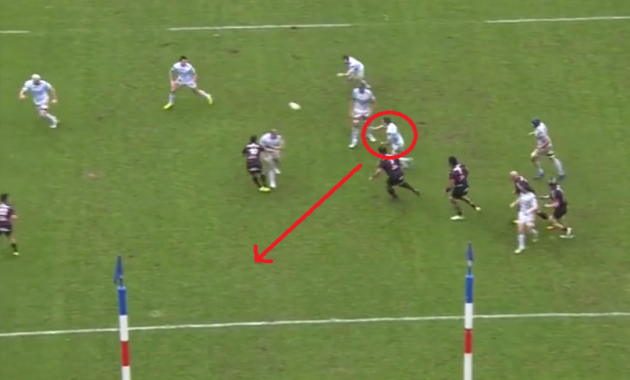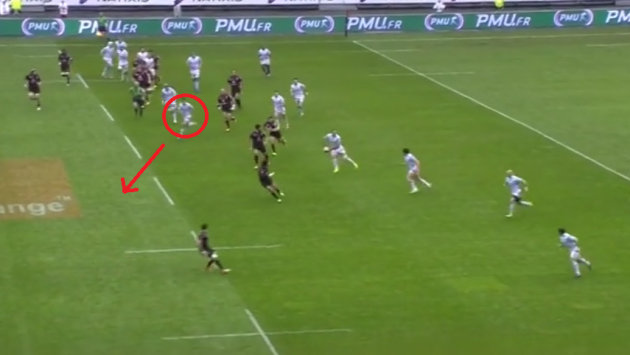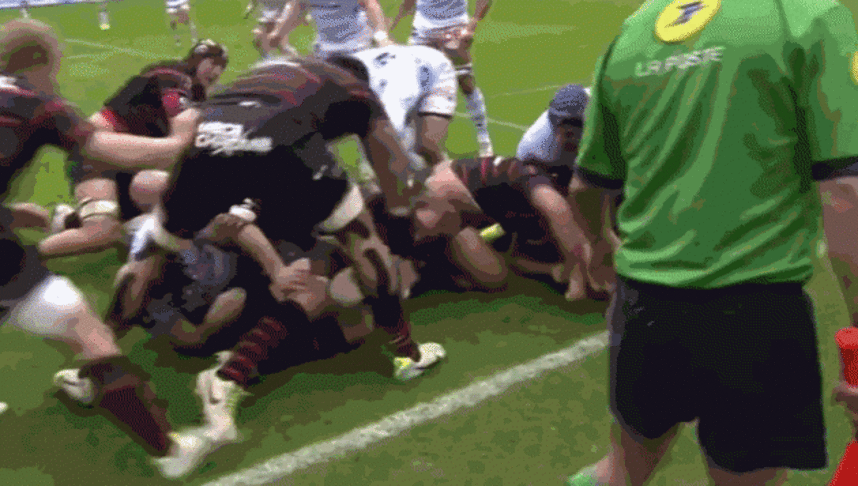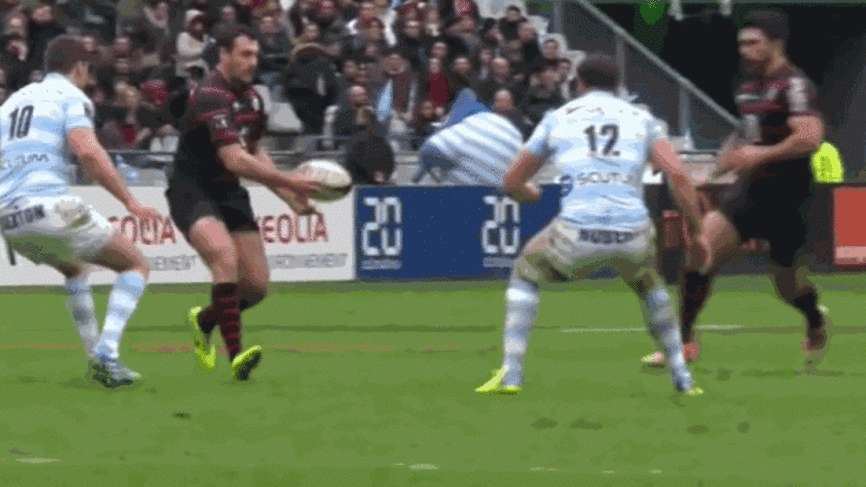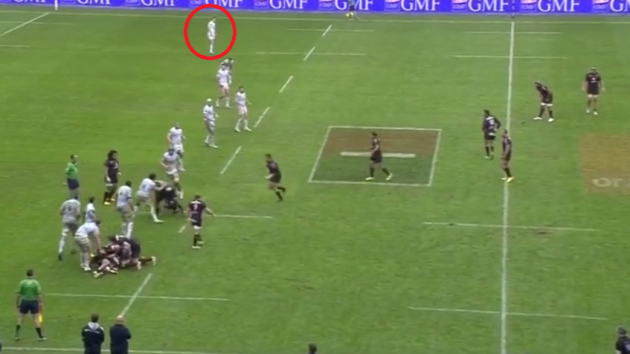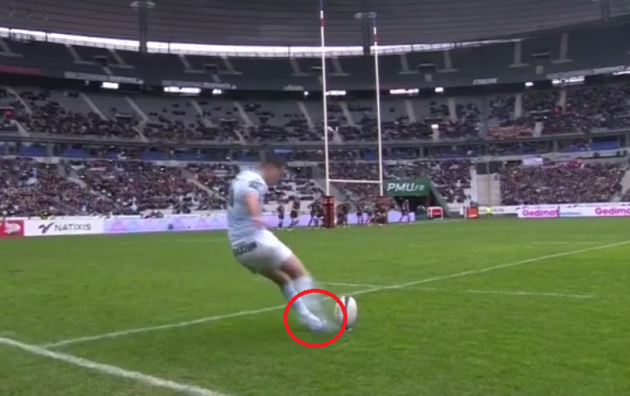DEPRIVED OF HIS most important player in Sean O’Brien for the Six Nations, Joe Schmidt is going to be even more reliant on Jonny Sexton to lead his Ireland team in the coming weeks, tactically and technically.
The former Leinster out-half has endured a frustrating few months at Racing Métro, with the Parisian club currently sitting eighth in the Top 14. The project there is ongoing, with coaches Laurent Labit and Laurent Travers attempting to build a lasting culture and working game plan.
Saturday’s home clash against Toulouse was seen as the turning point of Racing’s season, an opportunity to kick start the momentum that will hopefully carry them into the play-off positions by the end of the regular season. A 25-5 victory was certainly a step in the right direction, but it remains to be seen whether or not it is the start of a winning streak.
From an Irish point of view, the individual performance of Sexton was very encouraging as the Six Nations opener against Scotland looms. The 28-year-old has suffered slightly from his forwards’ inability to excel in the tight this season, but against Toulouse there were real signs of energy, creativity and detail from the Ireland out-half.
Kicking from hand
One of the most frustrating things for Sexton during this Top 14 campaign has been the kick-orientated game plan that les deux Laurents have favoured. While the former St. Mary’s man does possess strong kicking skills, he is more suited to an open, high-tempo, ball-in-hand approach.
Against Toulouse, Sexton kicked the ball a total of 18 times. That is by no means a record for an out-half and four of those were drop-offs to re-start the game. Kicking penalties down the line, Sexton looked composed and relaxed.
He has credited former Ireland coach Declan Kidney with asking him to go for greater distance on these types of kick, and it was good to see him pushing himself in that regard, rather than being safe and knocking the ball into touch a shorter distance away.
There were three booming garryowens [up and unders] from Sexton during his 74 minutes on the pitch too, another area where he excels. The height that the 28-year-old gets on this type of kick allows his chasers to get in underneath the ball and compete. One such effort led to substitute Fabrice Estebanez reclaiming possession in the air just outside the Toulouse 22.
Sexton is also a fan of using his boot to put the ball into attacking space in the wide channels. His cross-field kicks were always well-measured for Leinster and there was a nice example of something similar on Saturday [below].
Sexton spots the space early, and despite having the option to get there ball there by passing to Lapeyre, he dinks a soft, diagonal kick out to Juan Imhoff. The Argentinian winger might have been better served to accelerate earlier, catching the ball before it bounced, but it’s smart play from Sexton.
It’s also worth noting Sexton’s movement immediately after he has kicked the ball. He continues his running line, even accelerating into space beyond the defensive line. Many other out-halves would have faded off their kick, stepping back to watch how it worked out. Sexton never switches off.
Supporting lines
One of Joe Schmidt’s real pet peeves is seeing a player inactive off the ball. Even when play has moved to the other side of the field, he expects his players to work hard to provide width, run hypothetical supporting lines, distract defenders; do anything that may help the team to advance.
Sexton has been a keen student of that philosophy and as we indicated above, he never dies after kicking, passing or tackling. Against Toulouse, we saw very strong signs of that attitude returning to the fore and it’s certainly exciting to think of what he can do when he links those skills with the likes of Luke Fitzgerald and Brian O’Driscoll in attack.
An example serves best to illustrate Sexton’s efforts after passing.
Having passed the ball, the out-half is immediately focused on offering support to Juan Imhoff, who manages to make the half-break and offload. While it’s Marc Andreu who actually gets the scoring pop from Imhoff, you can see that Sexton is there, demanding the ball.
In the still below, Sexton is circled and the arrow indicates where he is going to run after his pass to Imhoff is completed. As ever, the Irish international is a step ahead of play, he sees where the offload could take place, where he might be needed in support.
We see another example below where Sexton makes his pass and then accelerates into space, hoping for and anticipating a line-break wider out. This time, nothing comes of the play as Jamie Roberts knocks-on, but it is still laudable that the 10 is doing that running.
Again, a still frame helps us to hammer home the point [below]. Sexton has passed the ball and he is actually ahead of play, almost a full two metres ahead. He has already taken that diagonal line across the field in anticipation of something happening.
It’s an element of the game that Schmidt drilled into Sexton during his time at Leinster; ‘What if there is a linebreak in midfield? What if someone gets their hands free for an offload?’ The out-half has worked hard to ensure that his work-rate never switches off after a nice pass or a slick attacking kick. There is always more he can do to ensure success.
Passing
Sexton passed the ball on 14 occasions for Racing at the Stade de France last weekend, only two of which we counted as inaccurate. One pass off his left hand was just a little indecisive in its execution, floating in between two prospective ball carriers, while the other was off his right hand and hit the back of a decoy runner to go to ground.
The other 12 were accurate and thrown with the ideal amount of weight. Sexton is good at recognising when a pass needs to be powerfully launched, and when a pop needs to be delicately left hanging for a supporting player. His technique is a lot more mechanical than someone like Ian Madigan, who coils his body up before releasing the pass with a whip of the upper body.
Sexton is more methodical in following through with straight arms, and ensuring that his leg movement stays ‘straight-up’ the pitch. Below, we see an example of one of his passes on Saturday.
It seems like a straightforward, easy pass and it is exactly that. It’s also well-executed and it gives Jamie Roberts the chance to run onto the ball. The very next pass from Roberts highlights Sexton’s competence, as the Welshman flings a poor effort up at Lapeyre’s head.
Sexton passed 10 times off his left-hand side and four off his right against Toulouse. Encouragingly, he doesn’t appear to have a ‘strong side’ in his passing game any longer. The dedicated training in this area that he has done has clearly left him equally comfortable off both sides.
Sexton also performs little pop passes in midfield well, with the linebreak assist for Roberts below providing us with a clear example.
Again, it doesn’t seem like much from Sexton, but his little dummy to Henry Chavancy on that switch line back inside him is enough to just unsettle the defence for a split second. While the linebreak is all about Roberts’ pace and power, the pop pass from Sexton needs to be at the ideal height and soft enough to allow the centre to steam onto it.
Running threat
One often hears Sexton referenced as a ‘playmaker’, but what exactly does that mean? For this writer, it is any player who dictates the decision-making on the pitch, but the term also refers to those players who can create attacking opportunities with little moments of ingenuity.
Sexton certainly fits the bill in that regard, and we saw some exciting examples for Racing against Saturday. The Dublin man’s impact in this area has been limited during this Top 14 campaign due to the fact that front-foot ball has been at a premium, but is was good to see Sexton flexing his creative muscles last weekend.
As the video below shows, the out-half gave the assist for Mike Phillips’ try in the first half after taking an offload from the wonderful Andreu and then rolling an intelligent grubber kick infield for Phillips.
The assist shows Sexton’s intelligence and his ever-present desire to keep the ball alive. It’s also an excellent touch with the boot, perfectly-weighted and well-directed. Another point to note is Sexton’s line of running after he kicks. He actually doesn’t attempt to fight to re-gather the ball, instead luring the covering Jano Vermaak away and leaving space for Phillips.
In the second half, we got another hint that Sexton is in good shape physically as he burst away down the right for a linebreak. The Lions out-half has had hamstring issues in the past year or so, but to see him get up to full speed on a couple of occasions was promising.
While he is no Anthony Watson, the ex-Leinster man possesses a decent turn of pace and his little dummy on Hosea Gear was classy too. While his pass to Imhoff was forward, this little piece of attacking incision will offer Schmidt hope ahead of the clash with Scotland on Sunday.
Sexton actually managed to chip in with a try of his own against Toulouse, scoring in the fifth minute following a blockdown on Lionel Beauxis by Jacques Cronje. It didn’t involve anything spectacular from Sexton himself, but is showed his awareness and desire. The 28-year-old appears to be physically and mentally sharp at the moment.
Defence
Sexton completed five tackles for Racing at the weekend, all of which were ‘assisted’ by other players. Generally, the out-half’s tackles will be carried out in traffic, close to the set-piece and he almost always has support from his back row or inside centre.
The Irishman has a particular fondness for going in high in the tackle, targeting the ball and looking to either strip it from the carrier’s hands or create a choke tackle situation. The fact that the players around him will very often go in low means that Sexton’s height is a plus rather than a disadvantage.
However, when he is forced to tackle one-on-one that height can lead to missed efforts. There were two examples of that against Toulouse, where ball carriers just slipped through his upper body challenges. However, neither was in a dangerous area of the field so it was not a major issue.
The GIF above shows us a typical Sexton tackle. The player inside him [Dan Lydiate in this case] goes in low around the ball carriers legs, while the out-half immediately targets the ball, looking to wrap it up or even rip it clear.
While Sexton is neither particularly massy or explosive in terms of muscle, he is relatively strong and combative in contact. That allows him to do well in these situations more often than not. He helped Racing turn Toulouse over later in the game by wrapping the ball up exactly like above and it lead to a choke tackle.
In phase play, for Ireland and Racing, we often see Sexton defending in the wider channels. Having completed his first tackle after the set piece, he will work his way out to the wing and defend there [as indicated below].
Sexton did exactly the same thing for the Lions last summer, and you may remember Israel Folau breezing past him to score in the first Test. It’s clearly a coaching decision to have Sexton occupy this channel in defence and it probably has something to do with having him in position to cover kicks in behind and then clear the ball with the boot.
It would be nice to see Sexton defending in tighter channels a little more often, however, given that he is one of the better defensive out-halves in world rugby.
Place-kicking
A quick word on Sexton’s place-kicking, particularly since it became something of an issue in the aftermath of the narrow defeat to the All Blacks in November. The 28-year-old has been performing well in this department for Racing, and he kicked four out of five efforts last weekend.
His first attempt of the day sailed wide to the right [below] and it looked a little forced in terms of power. Sexton is at his best from the tee when he strikes through the ball cleanly, without looking to overdo the speed of his kicking leg.
On this miss, he planted his left foot quite close to the ball, something that will often lead kickers to missing to the right of the posts. While Sexton himself is the only one who knows the exact reason for the miss, it was a difficult kick and not one he will be losing sleep over.
Thereafter, he struck the ball more cleanly and appeared to be more relaxed as he addressed the ball. The effort from 45 metres out in the first half was particularly excellent and demonstrated that more measured strike of the ball, not looking to murder the thing as he kicked it.
As an aside, keep an eye out for Sexton just saying something as he readies himself to kick [below]. At first it appears that he is giving himself a mental cue, but in reality he is asking Ronan O’Gara to step back and give him a bit of space!
Hitting form at the right time
The majority of the elements of Sexton’s performance against Toulouse that we have highlighted here will have been encouraging for Schmidt as the Six Nations kicks into gear. Oddly enough, it may be that a game last weekend was exactly what Sexton needed, particularly as Racing were comfortable winners.
The Ireland out-half will have arrived back in camp this week with his confidence boosted, and it is quite possible that his brief chats with the Kiwi coach last week were enough to return his focus to the little details that make his support play, passing and kicking of the highest standard.
The hope is that there is plenty more to come from Sexton over the next seven weeks.


